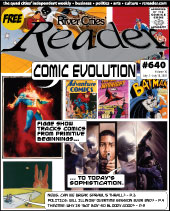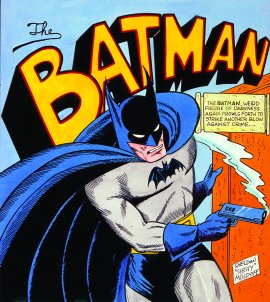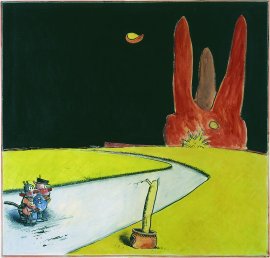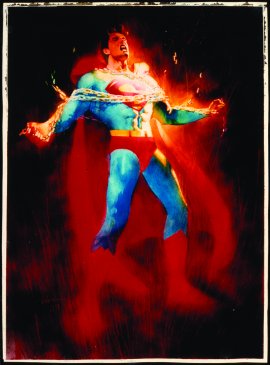 The Caped Crusader crashes through the window. A spray of glass shards partially melds into the two loosely rendered gray figures. Their ominous shapes and the frantic motion of the broken glass add tension to the pugilistic struggle that ensues. That is just part of the skull-thumping, chain-bursting action to be found in the Figge Art Museum's Comics, Heroes, & American Visual Culture, an exhibition light on context but rich with exciting visuals.
The Caped Crusader crashes through the window. A spray of glass shards partially melds into the two loosely rendered gray figures. Their ominous shapes and the frantic motion of the broken glass add tension to the pugilistic struggle that ensues. That is just part of the skull-thumping, chain-bursting action to be found in the Figge Art Museum's Comics, Heroes, & American Visual Culture, an exhibition light on context but rich with exciting visuals.
The show, on display through September 9 on the museum's third floor, is populated with more than 75 dynamic works - mostly pre-press layouts and conceptual sketches - from the collection of Dan F. and Barbara J. Howard. The pieces were donated to the University of Nebraska Foundation and previously shown at the university.
Comics, Heroes, & American Visual Culture is an eclectic mix of images from the superhero comics/graphic-novel realm and also the milieu of the daily newspaper. It's no surprise to find the chisel-shaped nose of Dick Tracy, the exaggerated physique of Superman, or the dual interpretations of Batman, but the show also offers characters such as Blondie, Captain Midnight, Buck Rogers, and The Spirit. The images are culled from a broad span of time, so the evolution of the comic format can be seen and experienced.
 The museum does point out social changes that made their ways into comics and some of the restrictive guidelines imposed in the 1950s on writers and illustrators by the Comics Code Authority (such as no overt violence or sexual innuendo). Yet the exhibition isn't an academic or dry blow-by-blow of specific events in society and when and how they showed themselves in comics. For the most part, the show is more about the visual enjoyment of comics and the evolution of the aesthetic than an analytical dissection of the topic. It is more eye-candy than a complex meal to digest.
The museum does point out social changes that made their ways into comics and some of the restrictive guidelines imposed in the 1950s on writers and illustrators by the Comics Code Authority (such as no overt violence or sexual innuendo). Yet the exhibition isn't an academic or dry blow-by-blow of specific events in society and when and how they showed themselves in comics. For the most part, the show is more about the visual enjoyment of comics and the evolution of the aesthetic than an analytical dissection of the topic. It is more eye-candy than a complex meal to digest.
The pieces in the exhibition are original works and are primarily preparatory sketches and camera-ready layouts made by various illustrators. For the most part, they were intended to be thrown away after production. The show does a good job explaining that many of the early comic artists were employees of the newspapers and owned no rights to the works they made. Their sketches, ideas, and layouts were merely a means to an end - the final printed piece - and therefore not thought of as something to keep. Comics didn't have the cultural cachet - or marketplace value - that they do today, making these surviving images that much rarer.
 Some of the works in Comics, Heroes, & American Visual Culture give the viewers insight into the image-making process. Serious image-makers (whether in comics, cinema, or "fine art") scrutinize, re-evaluate, and alter their choices to make a work stronger. Part of the joy of this show is seeing in some of the pieces the various layers of blue-colored-pencil drawing (a certain blue would remain "unseen" by the reproduction camera and therefore not end up in the final product), or notations to shift the direction of a character's head or enlarge a dialogue bubble to accommodate the text. These show the amount of restructuring and fine-tuning required to achieve the final image.
Some of the works in Comics, Heroes, & American Visual Culture give the viewers insight into the image-making process. Serious image-makers (whether in comics, cinema, or "fine art") scrutinize, re-evaluate, and alter their choices to make a work stronger. Part of the joy of this show is seeing in some of the pieces the various layers of blue-colored-pencil drawing (a certain blue would remain "unseen" by the reproduction camera and therefore not end up in the final product), or notations to shift the direction of a character's head or enlarge a dialogue bubble to accommodate the text. These show the amount of restructuring and fine-tuning required to achieve the final image.
Growing Sophistication
The earlier comics gave equal visual and narrative emphasis to each panel. The 1922 brush, ink, and watercolor strip from the long-running (1913 to 2000) Bringing Up Father - many people called it Maggie & Jiggs - is an excellent example, with a grid of 12 even-sized panels. In this case, the structure is over-emphasized by numbering the panels.
The action starts with Unkie (Jiggs) unable to go to Dinty Moore's party, where there will be fireworks. Eleven panels later, the story ends with Unkie accidentally burning down Dinty Moore's house with a beefy bottle rocket he shot over to send an attached message to Dinty. Each panel visually carries the same level of importance. Conceptually, some panels should be subservient to the other, more important ones, but consistency in format won out.
 As both the artists and their audiences became more visually sophisticated, so do the comics. In the brush-and-ink Superman Vs. Shazam (1978), artist Rich Buckler stacks three wedge-shaped panels to help the eye descend through the composition (much like the two figures who are plummeting to the ground) and heighten the action within the composition. To bring added emphasis to a distraught Superman, Buckler allows the character's head to violate the border of the bottom panel and invade the middle wedge. So while their downward struggle is intense, visually we know which panel carries the most significance, even before Superman says, "My God ...what have I done?"
As both the artists and their audiences became more visually sophisticated, so do the comics. In the brush-and-ink Superman Vs. Shazam (1978), artist Rich Buckler stacks three wedge-shaped panels to help the eye descend through the composition (much like the two figures who are plummeting to the ground) and heighten the action within the composition. To bring added emphasis to a distraught Superman, Buckler allows the character's head to violate the border of the bottom panel and invade the middle wedge. So while their downward struggle is intense, visually we know which panel carries the most significance, even before Superman says, "My God ...what have I done?"
The beginning of comics as we would recognize them (an ongoing storyline with serial characters in some mass print media) was ushered in with the daily newspapers, in the Hearst/Pulitzer era of the late 1890s. But according to the signs in the Figge's Orientation Gallery, modern comics' origins can be seen in late-Renaissance broadsheets, which were "sold or posted on street corners."
In addition to being able to experience the growing sophistication of visual sensibilities involved in comics, there is also an excellent example of a character's evolution. Comics, Heroes, & American Visual Culture showcases the various images and general disposition of Batman that were influenced by changes in society.
Batman started out in the late 1930s as a darker hero - one who, if need be, killed criminals with little or no remorse. But Batman was transformed to something softer, safer, and campier in the 1940s and '50s; the people drawing and writing his stories did not want to echo the horrors of World War II or sully the squeaky-clean façade of the McCarthy/J. Edgar Hoover era. The apex of Batman's camp occurred in the mid-1960s.
 In the mixed-media Jim Mooney cover Batman, Robin, & the Penguin, for example, we are immediately engaged by a pirate-like duel between the cutlass-swinging Caped Crusader and an umbrella-wielding Penguin. Robin swings in from the right side of the frame to land a well-placed power kick to some nameless underworld lackey destined to plunge overboard.
In the mixed-media Jim Mooney cover Batman, Robin, & the Penguin, for example, we are immediately engaged by a pirate-like duel between the cutlass-swinging Caped Crusader and an umbrella-wielding Penguin. Robin swings in from the right side of the frame to land a well-placed power kick to some nameless underworld lackey destined to plunge overboard.
The action, layout, and handling of the characters immediately conjures memories of the 1960s' Burt Ward and Adam West television incarnation of Batman. The good guys are one-dimensional in their goodness, and the bad guys are bad, but in a very mother-approving sort of way. Maniacal laughter and a few THWACK!s or KAPOW!s are all that are missing.
Contrast the bright and colorful Batman of the Cold War (when we sought sharp distinctions between "us" and "them") with more recent incarnations (particularly since the 1986 release of Frank Miller's The Dark Knight Returns), and you'll experience a hero who now inhabits a gray realm of shadow and mist and is nearly as flawed and tormented as the bad guys he fights. Not only do you have a more compelling character to follow, but he dwells in a grittier and more realistic world.
Are Comics Art?
 Many people do not consider comics to be "art," or at least "Art" with a capital "A." Even after Pop artists such as Roy Lichtenstein (1923-1997) extensively mined comics for image ideas, they were still considered a bastard cousin at best. This can be tied to four imposing yet terminally flawed arguments.
Many people do not consider comics to be "art," or at least "Art" with a capital "A." Even after Pop artists such as Roy Lichtenstein (1923-1997) extensively mined comics for image ideas, they were still considered a bastard cousin at best. This can be tied to four imposing yet terminally flawed arguments.
Part of art's "arty-ness" comes from its unique handcrafted-nature. Opponents would argue that comics are crass because they are mass-produced. But this fortress of snobbery is breached by art history itself, unless you wish to argue that the woodcuts of Albrecht Durer or the etchings of Francisco Goya and Rembrandt are somehow not art because they were produced in large numbers.
Another argument is that comics aren't Art because their creators were hired by someone to make them, contrasted with some romantic idea of the impoverished artist slaving away in solitude. Somehow money contaminates "true art." But Michelangelo's paintings in the Sistine Chapel were commissioned, and who would argue that they aren't art just because they were partially paid for in advance?
Comics are also derided for being simplistic kiddie-fare, with their unsophisticated plots. Yet the creation of a visual storyline still involves innumerable intellectual, narrative, and compositional decisions about how to communicate those stories. Masaccio's frescoes in the Brancacci Chapel were simple enough to be understood by the illiterate masses. Are they art because they are old and painted on plaster, or because visually they are structured in a way to speak to their viewers?
Another aspect of the Are comics Art? debate is the intent of their creators. Marcel Duchamp (the grandfather of conceptual art) dismissed the physical manipulation of media as being less important than the intellectual activity of selecting and declaring something to be "Art." His piece Fountain - a urinal conceptually converted into "Art" through that process - irrevocably opened the door. Only one question needs to be answered: Did the creators of comics intend them to be considered Art? Most interviews I have heard (at least with contemporary comic artists) point toward "yes."
A Better Mirror
 Just outside the exhibition is a small TV that runs a loop of Superman cartoons from the early 1940s. The cartoons seem to revel in the type of absurdity that was lampooned in Austin Powers movies. Why would Clark Kent need someone fly him in a plane to the bad guys' lair so he can parachute in to save the day? Who insists on maintaining a large cauldron of liquid metal in the center of their hideout with an unnecessarily slow dipping mechanism? Does a laser beam actually use steam-driven pistons?
Just outside the exhibition is a small TV that runs a loop of Superman cartoons from the early 1940s. The cartoons seem to revel in the type of absurdity that was lampooned in Austin Powers movies. Why would Clark Kent need someone fly him in a plane to the bad guys' lair so he can parachute in to save the day? Who insists on maintaining a large cauldron of liquid metal in the center of their hideout with an unnecessarily slow dipping mechanism? Does a laser beam actually use steam-driven pistons?
But the cartoons serve as an interesting counterpoint to the show itself, and hint at some of its contextual shortcomings. While there are some racist undertones in the comics in the show, one of the Superman cartoons features evil, drum-beating, big-lipped "natives" who fled as soon as the large white guy showed up. Also, there were numerous racial slurs against the Japanese, including one cartoon titled Japateurs.
These cartoons serve as an important bookmark to a chapter in our history. The early 1940s were a time when the U.S. military was still racially segregated, West coast Japanese Americans were in "war relocation centers," and the unconscionable 40-year Tuskegee syphilis study was underway. It should come as no surprise (although it still feels caustic to the soul) that little or no thought was given to using the word "Jap," or depicting blacks as easily frightened, drum-thumping savages.
 In some respects, the comics show is a more honest chronicling of and mirror to our society and its prejudices than the "high art" of the time. Do the Abstract Expressionist works of Jackson Pollock or Willem DeKooning from the 1940s and 1950s betray any hint of the social changes rippling through our country? No.
In some respects, the comics show is a more honest chronicling of and mirror to our society and its prejudices than the "high art" of the time. Do the Abstract Expressionist works of Jackson Pollock or Willem DeKooning from the 1940s and 1950s betray any hint of the social changes rippling through our country? No.
Can we see signs of our social transformations within the art of comics? Yes.
Unfortunately, the time span represented in Comics, Heroes, & American Visual Culture is too great, and even at 76 works, the show is too small to explore in-depth the effects of comics on our culture.
Visually, the show is solidly enjoyable. Conceptually, it could be enhanced with more direct connections to the history of which it is a part.








